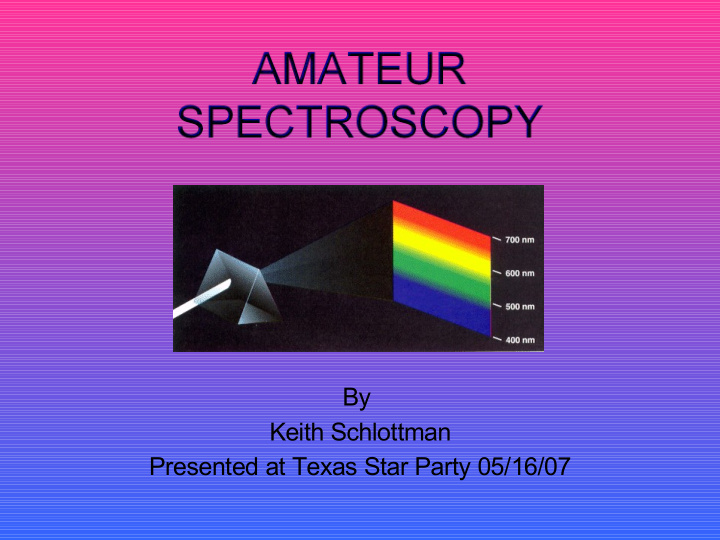



By Keith Schlottman Presented at Texas Star Party 05/16/07
Have You Ever Used Spectroscopy? Used a Nebula Filter? Noticed that Vega is Bluish and Arcturus is Seen a Rainbow? Reddish? Viewed the Sun in H-Alpha?
The Spectrum Tells A Story • Stars – Stellar classifications / HR Diagram – Age of star – Surface gravity – Pressure – Surface temperature – Radial velocity – Identify spectroscopic binaries • Other Objects – Galactic and Quasar redshifts – Nebular compositions – Comets and Planets
Equipment – Visual Spectroscopy • Prism • CD-ROM • Project Star Spectrometer • Naked Eye (Rainbows & Moonbows)
Equipment – Telescopic Spectrographs • More Expensive • SBIG SGS • LHIRES III • Baader DADOS • Sivo Scientific Nu-View II • Moderately Expensive • SBIG DSS-7 • Less Expensive • DG Spectrum Filters • Rainbow Optics Star Spectroscopes • Rigel Systems RS-Spectroscope • Paton Hawksley Star Analyser • Build Your Own
Comparison of 4 Spectrographs SBIG SGS SBIG DSS7 LHIRES III DG1 FILTER COST $4,950 $1,595 ~ $3,000 ~ $150 GRATING TYPE Reflection Reflection Reflection Transmission GRATING 150 (Low) 100 150, 300, 600, 200, 500, or Lines/mm 600 (High) 1200, 2400 1,000 DISPERSION 4.3 (Low) 5.4 3.0 (Lowest) to Up to 0.5 Angst./pixel w/ST-7 1.1 (High) 0.12 (Highest) RESOLUTION 9Å (Low) 16Å Up to 0.4Å Varies With ST-7 2.4Å (High) λ RANGE Tuneable Fixed Tuneable Fixed GUIDING Internal or None or Separate or Internal or External External External External BEST FOR Stars, Nebulae, Stars Stars Nebulae Galaxies Information based on my experience and manufacturer claims, may not be 100% accurate
Acquiring Data With the SGS • Use CCDSoft • Guide on Slit • Binning 1x4 • Note that images are monochrome!
Processing Data • Dark Subtract, Median Combine (CCDStack) • Rotate if Low-Res Mode (IRIS) • Wavelength Calibration (vSpec) • Flux Calibration for CCD Response (equivalent to Flat Field)
Wavelength Calibration - H Edmund Scientific Lamps are used
Spectral Types Spectra taken with The SBIG SGS on a 12” LX-200GPS from my BLUE Tucson backyard on RED October 16 & 17, 2006.
Identifying Stellar Composition
Emission Nebula The OIII emission lines were thought to be a new element in the early 20 th century, “Nebulium”.
Emission Nebulae
Planets
Comets
Novae
Variable Stars
Pro-Am Collaborations Amateur spectroscopists were asked to obtain data on this star, which was a target for the COROT satellite.
Be Stars
Young Stars
A very young star, still undergoing contraction. T Tauri
This data was Texas Star Party 2007 obtained early Monday morning at TSP Upper Field. Blueshifted absorption feature provides a basis for calculating radial velocity of the expanding shell. Preliminary calculation from this data is ~ 200 km/sec.
DG Spectrum Filter • Zero and First Order on Main Chip Vega • Use Known Lines to Calibrate in vSpec
The Easiest Spectrum to Observe – No Equipment Necessary! For more information see: http://www.xanaduobservatory.com
Recommend
More recommend